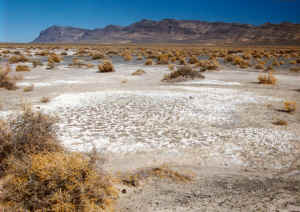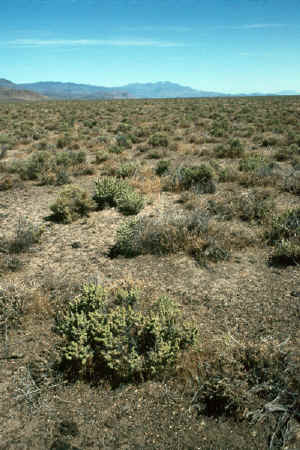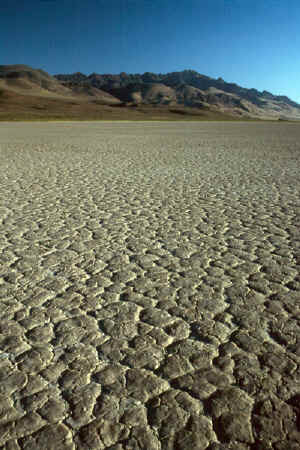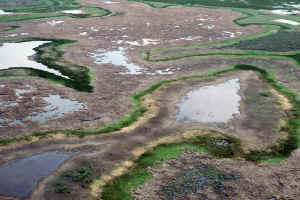No. 18. Desert Playa and Salt Scrub Shrublands
Rex C. Crawford and Jimmy Kagan
Geographic Distribution. The desert playa and salt scrub habitat centers
on the Great Basin of Nevada and Utah. In the Pacific Northwest, it is most
common and abundant in the larger, alkaline lake basins in southeastern Oregon,
although it is represented throughout the Columbia Plateau, Basin and Range, and
Owyhee Provinces.
Shadscale salt desert shrub and mixed salt desert shrub range
from southeastern Oregon south into Utah and Nevada. Black greasewood salt
desert scrub and alkaline/saline bottomland grasslands and wetlands appear
throughout the Columbia Plateau of Washington and Oregon.
 Physical Setting. This habitat typically occupies the lowest elevations
in hydrologic basins in the driest regions of the Pacific Northwest. Elevation
range is highly variable, from 3,000 to 7,500 ft (914 to 2.286 m) in
southeastern Oregon to 500 to 5,500 ft (152-1,676 m) in central Washington.
Structural and compositional variation in this habitat are related to changes in
salinity and fluctuations in the water table. Areas with little or no vegetative
cover have highly alkaline and saline soils and are poorly drained or
irregularly flooded. Other arid soil types include desert pavement and barren
ash. The wettest variants of the habitat are usually found at the mouth of
stream drainages or in areas with some freshwater input into a playa. These have
finer, deeper alluvial soils that occur in low alkaline dunes, around playas, on
slopes above alkaline basins or in small, poorly drained basins in sagebrush
steppe. Topographically, this habitat occurs on playas or desert pavement, or on
low benches above playas with occasional low alkaline dune ridges. Physical Setting. This habitat typically occupies the lowest elevations
in hydrologic basins in the driest regions of the Pacific Northwest. Elevation
range is highly variable, from 3,000 to 7,500 ft (914 to 2.286 m) in
southeastern Oregon to 500 to 5,500 ft (152-1,676 m) in central Washington.
Structural and compositional variation in this habitat are related to changes in
salinity and fluctuations in the water table. Areas with little or no vegetative
cover have highly alkaline and saline soils and are poorly drained or
irregularly flooded. Other arid soil types include desert pavement and barren
ash. The wettest variants of the habitat are usually found at the mouth of
stream drainages or in areas with some freshwater input into a playa. These have
finer, deeper alluvial soils that occur in low alkaline dunes, around playas, on
slopes above alkaline basins or in small, poorly drained basins in sagebrush
steppe. Topographically, this habitat occurs on playas or desert pavement, or on
low benches above playas with occasional low alkaline dune ridges.
 Landscape Setting. This habitat is typically surrounded by
shrub-steppe
habitat. It forms a habitat mosaic of playas, salt grass meadows, salt desert
shrublands and sagebrush shrublands. This habitat may be associated with
Herbaceous Wetland habitat. Local land use can result in juxtaposition with
Agriculture or Eastside Grasslands habitat. Most of this habitat provides
rangeland for livestock, particularly as winter range. Portions of this habitat
associated with water are most attractive to livestock. Other portions of this
type are designated wildlife refuges. Landscape Setting. This habitat is typically surrounded by
shrub-steppe
habitat. It forms a habitat mosaic of playas, salt grass meadows, salt desert
shrublands and sagebrush shrublands. This habitat may be associated with
Herbaceous Wetland habitat. Local land use can result in juxtaposition with
Agriculture or Eastside Grasslands habitat. Most of this habitat provides
rangeland for livestock, particularly as winter range. Portions of this habitat
associated with water are most attractive to livestock. Other portions of this
type are designated wildlife refuges.
Structure. This habitat is structurally diverse, ranging from dense
shrublands to sparse grasslands to non-vegetated flats. Generally, low to
medium-tall alkali or saline tolerant shrubs form an open layer over a grass and
annual, often succulent, forb undergrowth. Deciduous shrubs, when present,
usually create <50% cover but occasionally can exceed 70% on previously
disturbed ground. Ground cover between shrubs is variable, ranging from widely
spaced tall, medium-tall, or short bunchgrasses to dense, short rhizomatous
grasses. Other areas have no shrubs and support a fairly continuous cover of
graminoids, occasionally with widely spaced bunchgrasses. Sites can have
extensive bare ground, usually gravelly flats, ash, desert pavement, or low
alkaline dune ridges. Typically, this habitat is a mosaic of open medium-tall to
low shrubland communities, patchy grasslands or herb lands, and sparsely to
non-vegetated areas.
Composition. Characteristic medium-tall shrubs that dominate well-drained
sites are shadscale (Atriplex confertifolia), bud sagebrush (Artemisia
spinescens), and hopsage (Grayia spinosa). Characteristic low shrubs
are greenmolly (Kochia americana), saltbush (Atriplex gardneri or
A. nuttallii), and winter fat (Krascheninnikovia lanata). Other
medium-tall shrubs, big sagebrush (Artemisia tridentata), horsebrush (Tetradymia
nuttallii or T. glabrata), Mormon tea (Ephedra viridis), or
rabbitbrush (Chrysothamnus nauseosus or C. viscidiflorus) can be
co-dominant. The medium-tall shrub black greasewood (Sarcobatus vermiculatus)
or low shrubs, iodinebush (Allenrolfea occidentalis) or Mojave seablite (Suaeda
moquinii) can be dominant or co-dominant on less well drained, generally
more saline parts of this habitat.
 Herbaceous indicators of salt desert habitats appear in various habitats. On
densely vegetated sites, native bunchgrasses, basin wildrye (Leymus
cinereus), curly bluegrass (Poa secunda), and needle-and-threadgrass
(Stipa comata) are important, usually with shrubs in this habitat. Basin
wildrye is also a common and diagnostic grass in sites with less alkaline,
deeper soils and some movement of water. Indian ricegrass (Oryzopsis
hymenoides) and bottlebrush squirreltail (Elymus elymoides)
are dominant grasses on the alkaline dunes. Introduced plants, particularly,
cheatgrass (Bromus tectorum) or halogeton (Halogeton glomeratus)
often dominate overgrazed sites. Saltgrass (Distichlis spicata) is
a common, diagnostic native sod-forming grass on more saline sites that often
dominates large areas with and without shrubs. Pickleweed (Salicornia
virginica) is found in wetter, saline areas. Alkaline sites have mat muhly (Muhlenbergia
richardsonis), alkali bluegrass (Poa secunda ssp.
juncifolia), beardless wildrye (Leymus triticoides), and
Lemmonís alkaligrass (Puccinella lemmonii). Common reedgrass (Phragmites
australis), bulrush (Scirpus americanus, S. maritimus), and
creeping spikerush (Eleocharis palustris) are diagnostic of the wettest
parts of this habitat. Herbaceous indicators of salt desert habitats appear in various habitats. On
densely vegetated sites, native bunchgrasses, basin wildrye (Leymus
cinereus), curly bluegrass (Poa secunda), and needle-and-threadgrass
(Stipa comata) are important, usually with shrubs in this habitat. Basin
wildrye is also a common and diagnostic grass in sites with less alkaline,
deeper soils and some movement of water. Indian ricegrass (Oryzopsis
hymenoides) and bottlebrush squirreltail (Elymus elymoides)
are dominant grasses on the alkaline dunes. Introduced plants, particularly,
cheatgrass (Bromus tectorum) or halogeton (Halogeton glomeratus)
often dominate overgrazed sites. Saltgrass (Distichlis spicata) is
a common, diagnostic native sod-forming grass on more saline sites that often
dominates large areas with and without shrubs. Pickleweed (Salicornia
virginica) is found in wetter, saline areas. Alkaline sites have mat muhly (Muhlenbergia
richardsonis), alkali bluegrass (Poa secunda ssp.
juncifolia), beardless wildrye (Leymus triticoides), and
Lemmonís alkaligrass (Puccinella lemmonii). Common reedgrass (Phragmites
australis), bulrush (Scirpus americanus, S. maritimus), and
creeping spikerush (Eleocharis palustris) are diagnostic of the wettest
parts of this habitat.
 Other Classifications and Key References. Popular literature refers to
this habitat as shadscale, salt desert scrub, and saltflat desert. This habitat
encompasses the "Desert or Salt Desert Shrub" and "Distichlis
stricta Associations on Saline-Alkali Soils" in Franklin and Dyrness 88
and Saltbush-greasewood in Kuchler 136. The Oregon Gap II Project 126
and Oregon Vegetation Landscape-Level Cover Types 127 that would
represent this type are salt desert scrub shrubland and alkali playa. Other
references describe this habitat 29, 30, 52, 60, 123, 131, 147, 175, 184. Other Classifications and Key References. Popular literature refers to
this habitat as shadscale, salt desert scrub, and saltflat desert. This habitat
encompasses the "Desert or Salt Desert Shrub" and "Distichlis
stricta Associations on Saline-Alkali Soils" in Franklin and Dyrness 88
and Saltbush-greasewood in Kuchler 136. The Oregon Gap II Project 126
and Oregon Vegetation Landscape-Level Cover Types 127 that would
represent this type are salt desert scrub shrubland and alkali playa. Other
references describe this habitat 29, 30, 52, 60, 123, 131, 147, 175, 184.
Natural Disturbance Regime. Fire plays a minor role over much of the
distribution of the type because of sparse vegetation and lack of fuel. Many of
these areas are prone to irregular flooding and prolonged droughts; both factors
lead to a redistribution of component species and creation of sparsely or
unvegetated areas.
Succession and Stand Dynamics. Many of the dominant shrub species sprout
following fire, herbicide treatments, or heavy grazing 4. The
characteristic shrubs of this habitat increase with grazing and can invade
adjacent big sagebrush communities with intense grazing.
 Effects of Management and Anthropogenic Impacts. Several exotic species
invade this habitat with grazing. Halogeton, a toxic exotic plant, is found most
commonly in this habitat. Other noxious but nontoxic exotics that increase with
grazing are Russian thistle (Salsola kali), tall tumblemustard (Sisymbrium
altissimum), and cheatgrass. These can replace native grasses and change the
structure of the native habitat. Effects of Management and Anthropogenic Impacts. Several exotic species
invade this habitat with grazing. Halogeton, a toxic exotic plant, is found most
commonly in this habitat. Other noxious but nontoxic exotics that increase with
grazing are Russian thistle (Salsola kali), tall tumblemustard (Sisymbrium
altissimum), and cheatgrass. These can replace native grasses and change the
structure of the native habitat.
Status and Trends. Agricultural development is generally not feasible;
consequently, little of this habitat is converted to other uses. Most of this
habitat is used for livestock grazing, which overall has increased shrub and
annual cover and decreased bunchgrass cover. Quigley and Arbelbide 181
concluded that the Salt Desert Shrub cover type is less abundant now than before
1900. They further noted that the cover type has undergone a moderate level of
change, so that some successional pathways have been unaltered. Approximately
one third of Pacific Northwest salt desert and related community types listed in
the National Vegetation Classification are considered imperiled or critically
imperiled 10.
[ Top ]
[ Literature Citations ]
[ Wildlife-Habitat Types - Table 1 ]
|